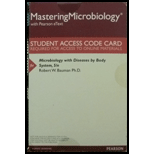
Microbiology: With Diseases By... -Access
5th Edition
ISBN: 9780134626369
Author: BAUMAN
Publisher: PEARSON
expand_more
expand_more
format_list_bulleted
Concept explainers
Question
Chapter 3, Problem 6SA
Summary Introduction
To answer:
The difference between the growth and reproduction.
Introduction:
The factors that separate the living and non-living are reproduction, responsiveness, growth, and
Expert Solution & Answer
Want to see the full answer?
Check out a sample textbook solution
Students have asked these similar questions
What do we call the chemicals that cells need to work and reproduce?
what is cell reproduction
What are the functions of a cell wall?
Chapter 3 Solutions
Microbiology: With Diseases By... -Access
Ch. 3 - Prob. 1TMWCh. 3 - In 1985, an Israeli scientist discovered the...Ch. 3 - Why is a pilus a type of fimbria, but a flagellum...Ch. 3 - Why is the microbe illustrated in Figure 3.2 more...Ch. 3 - The Big Game College sophomore Nadia is a star...Ch. 3 - When the bacterium Escherichia coli is grown in a...Ch. 3 - Prob. 6TMWCh. 3 - Why do scientists consider bacterial and archaeal...Ch. 3 - Why did scientists in the 19th and early 20th...Ch. 3 - Why do some scientists consider archaea, which are...
Ch. 3 - Why are eukaryotic glycocalyces covalently bound...Ch. 3 - Many antimicrobial drugs target bacterial cell...Ch. 3 - Colchicine is a drug that inhibits microtubule...Ch. 3 - A cell may allow a large or charged chemical to...Ch. 3 - Which of the following statements concerning...Ch. 3 - A 9 + 2 arrangement of microtubules is seen in...Ch. 3 - Which of the following is most associated with...Ch. 3 - Which of the following is not associated with...Ch. 3 - Which of the following is true of Svedbergs? a....Ch. 3 - Which of the following statements is true? a. The...Ch. 3 - Prob. 8MCCh. 3 - Bacterial flagella are ______________. a. anchored...Ch. 3 - Prob. 10MCCh. 3 - A Gram-negative cell is moving uric acid across...Ch. 3 - Gram-positive bacteria _______________. a. have a...Ch. 3 - Endospores ________________. a. are reproductive...Ch. 3 - Prob. 14MCCh. 3 - Dipicolinic acid is an important component of...Ch. 3 - Match the structures on the left with the...Ch. 3 - Match the term on the left with its description on...Ch. 3 - Label the structures of the following prokaryotic...Ch. 3 - Label each type of flagellar arrangement.Ch. 3 - A scientist who is studying passive movement of...Ch. 3 - Describe (or draw) an example of diffusion down a...Ch. 3 - Sketch, name, and describe three flagellar...Ch. 3 - Prob. 3SACh. 3 - The term fluid mosaic has been used in describing...Ch. 3 - A local newspaper writer has contacted you, an...Ch. 3 - Prob. 6SACh. 3 - Compare bacterial cells and algal cells, giving at...Ch. 3 - Contrast a cell of Streptococcus pyogenes (a...Ch. 3 - Differentiate among pili, fimbriae, and cilia,...Ch. 3 - Prob. 10SACh. 3 - Prob. 11SACh. 3 - Prob. 12SACh. 3 - What is the function of glycocalyces and fimbriae...Ch. 3 - Prob. 14SACh. 3 - Compare and contrast three types of passive...Ch. 3 - Prob. 16SACh. 3 - Prob. 17SACh. 3 - Prob. 18SACh. 3 - Prob. 1CTCh. 3 - Methylene blue binds to DNA. What structures in a...Ch. 3 - Prob. 3CTCh. 3 - Prob. 4CTCh. 3 - A researcher carefully inserts an electrode into...Ch. 3 - Prob. 6CTCh. 3 - An electron micrograph of a newly discovered cell...Ch. 3 - An entry in a recent scientific journal reports...Ch. 3 - Prob. 9CTCh. 3 - Prob. 10CTCh. 3 - Prob. 11CTCh. 3 - Prob. 12CTCh. 3 - Prob. 13CTCh. 3 - Prob. 14CTCh. 3 - Using the following terms, fill in the following...
Knowledge Booster
Learn more about
Need a deep-dive on the concept behind this application? Look no further. Learn more about this topic, biology and related others by exploring similar questions and additional content below.Similar questions
arrow_back_ios
arrow_forward_ios
Recommended textbooks for you
 Biology Today and Tomorrow without Physiology (Mi...BiologyISBN:9781305117396Author:Cecie Starr, Christine Evers, Lisa StarrPublisher:Cengage Learning
Biology Today and Tomorrow without Physiology (Mi...BiologyISBN:9781305117396Author:Cecie Starr, Christine Evers, Lisa StarrPublisher:Cengage Learning

Biology Today and Tomorrow without Physiology (Mi...
Biology
ISBN:9781305117396
Author:Cecie Starr, Christine Evers, Lisa Starr
Publisher:Cengage Learning